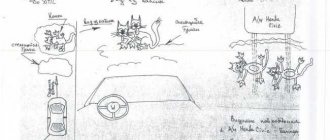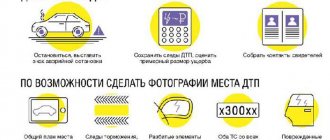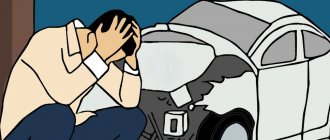Why is accident analysis necessary?
When the causes of the accident and its culprit do not raise any questions for the traffic police inspector, then he simply writes a resolution on the administrative offense, right on the spot. Of course, there are cases when the investigation of an accident simply requires additional measures, or causes disagreements in determining the culprit, then the employee must draw up a report of the incident, and then all the materials on the case are sent to the district department of the traffic police, and the rest of the proceedings will take place there. All participants in an accident must sign a consent to appear for further analysis.
The investigation is being carried out by a special administrative practice group. The main task of the group is a detailed study of all events, and most importantly, the true causes of the accident. It will also be necessary to determine the degree of guilt of each participant. This procedure is simply necessary to ensure that the right decision is made and all the necessary documents are completed.
According to the article of the Criminal Code, the period for conducting an administrative investigation should be no more than one month from the moment the criminal case was initiated. There are rare cases when, at the written request of the investigator, it can be extended.
Only the head of a higher authority can extend the period. They mainly require an extension of the deadline when there are casualties in the accident. They are sent to undergo a medical examination in order to determine the full severity of the herbs that he received in the accident. This procedure takes a very long period of time.
How is a driver’s fault in an accident determined?
Guilt in an accident occurs when the driver ignored the requirements of the traffic rules. In serious accidents, several different traffic rules are violated at the same time.
In order for the picture to be complete, it is necessary to establish a cause-and-effect relationship between non-compliance with regulatory requirements and the resulting consequences.
The above applies regardless of what responsibility awaits the driver next: administrative or criminal. To determine punishment, the degree of culpability in the accident is essential.
Conditions affecting the degree of guilt:
- the condition of the driver, whether he was drunk or sober;
- actions of other participants in the incident, including pedestrians;
- illumination of the section of the highway where the accident occurred, accompanying weather conditions;
- the quality of the road surface, the correctness of markings and installation of signs;
- serviceability of the vehicle itself.
Often both drivers are responsible for an accident. In this case, we are talking about mutual guilt. Its presence does not affect the administrative punishment, but may affect the content of the sentence in a criminal case.
There are often situations when, from the materials compiled by the traffic police officers, it is impossible to reliably determine the culprit of the accident. Then the degree of guilt of each driver in percentage is determined by the court, subject to the filing of an appropriate claim by one of the participants in the road accident.
Compensation for material damage also occurs in proportion. For example, when the court distributes the fault of car owners as 70 to 30%, damage caused to vehicles is also compensated.
If the culprit dies, payments are made by his insurance; if the limits are exceeded, the burden of compensation is borne by the heirs.
There are the most common causes of accidents due to the driver's fault. They can be formed in the form of a list like this.
Factors of a traffic accident:
- Lack of proper driving skills, imprudence, negligence.
- Exceeding the speed limit, avoiding road signs and markings on the asphalt.
- Ignoring traffic lights and traffic controller instructions.
- Being under the influence of alcohol, drugs, psychotropic substances.
- Traveling on a faulty vehicle.
The consequence of an accident may be poor road surface conditions or difficult weather conditions.
Here the driver’s fault most often lies in the lack of required precautions. They imply reducing speed to a minimum and increasing the safe distance to vehicles moving ahead.
Often the actions of other drivers contribute to the occurrence of an accident. “Cutting off”, driving into the oncoming lane is aggressive behavior in itself. Then the citizens sitting behind the wheel, avoiding a collision, unwittingly get into an accident.
Lawyer, more than 1 year experience.
Ask a question
In such situations, court decisions indicate that those who caused the accident are considered to be involved. Traffic cameras and witness statements help identify violators.
In a situation where an accident occurs on the road, the driver’s guilt is established both without delay, and after having already collected a package of documents. It all depends on the scale of the incident and the number of vehicles involved. Driver behavior plays an important role.
Many years of practice have developed not only an algorithm for identifying the culprit of the accident, but also the correct tactics of behavior for all its participants.
Some regulations are directly enshrined in the traffic rules, as well as in the Code of Administrative Offenses of the Russian Federation.
For example, the procedure for action in the event of a traffic accident is regulated in paragraphs. 2.5, 2.6, 2.6.1. In turn, the procedure for proceedings in cases of administrative offenses, the rights of their participants, and other important provisions are contained in Chapters 24-26, 28 of Section IV of the Code of Administrative Offences.
The collected evidence base in its entirety plays a major role in ascertaining the truth. It is on its basis that a decision is made to bring a citizen to administrative or criminal liability.
Approximate list of evidence;
- written sources;
- photos;
- explanations of road accident participants, witnesses, traffic police officers;
- physical evidence in the form of glass shards or paint chips;
- results of examinations, examination of a person.
The readings of special technical means are also taken into account. We are talking about speed radars and devices that determine the level of alcohol in the driver's blood.
Now is the time to move on to the procedure for identifying the culprit.
At the scene of an accident
In many cases, the culprit of a car accident becomes clear immediately. Most traffic violations are obvious and do not require additional methods of proof.
The circumstances of the incident are included in the protocol being drawn up with reference to those traffic rules that were not observed. The accident diagram will tell you a lot.
Typical offenses of motorists:
- running a red light;
- obvious speeding;
- failure to comply with the rules for crossing intersections;
- driving into the oncoming lane.
In the case where the driver was drunk, this also applies to non-compliance with traffic rules (Article 12.8.1 of the Code of Administrative Offenses of the Russian Federation). Initially, the amount of alcohol in a citizen’s blood is determined by a traffic police officer using a special device - a breathalyzer. This is usually followed by a medical examination.
Each of the participants in the incident has the right to write their own explanations to the protocol. Their content is taken into account when issuing a decision to impose a fine and/or determining the period for deprivation of a driver’s license.
Upon the fact of a traffic accident, administrative proceedings are initiated. The initial documents within it are a diagram drawn up at the scene of the accident, explanations of participants and witnesses.
In turn, between the registration of the case materials and the adoption of a resolution to bring the culprit to administrative responsibility, a certain period of time passes - 2 months.
During this period, the driver should not sit with his hands folded in order to confirm that he is right.
Basic rights of the car owner:
- opportunity to get acquainted with the materials of administrative proceedings;
- providing additional explanations and written evidence;
- the right to seek legal assistance from a lawyer or advocate.
In addition, the participant in the accident may insist on additional examinations. They, on the basis of Part 2 of Art. 27 of the Code of Administrative Offenses of the Russian Federation are carried out at the expense of budgetary funds. The range of questions that need to be posed to the expert are determined in advance.
The logical outcome of an accident is the decision of the traffic police investigator to bring one or both drivers to administrative responsibility in the form of a fine. It can be challenged. For this purpose, a person brought to administrative responsibility has the right to file a complaint with higher management or the district court.
We suggest you familiarize yourself with: Assigning a car to a manager. Assigning a driver Sample order on assigning vehicles to drivers
The protocol on an administrative offense cannot be challenged under the law. You need to wait for the decision to impose a fine.
Many choose the second path in the hope of greater objectivity. Be that as it may, everything must be done within ten days from the date of receipt of the decision. Otherwise, you will have to write a petition to restore lost time, justifying the reasons for the delay.
An appeal against a decision may take place sequentially in several courts. Many drivers, in search of justice, go all the way to the Supreme Court of the Russian Federation.
By the way, the decision not only on the application of monetary sanctions is being appealed, but also on the refusal to bring the citizen to administrative responsibility. The same 10 day rule applies here. The complaint requires a point-by-point description of the procedural violations committed by the traffic police officer.
If the magistrate refuses to initiate administrative proceedings, his ruling may be revised. For this purpose, a complaint is written to the district court at the location of the magistrate’s precinct.
In civil court
The consideration of the case has its own specifics. A claim is brought against the second party not only for the recovery of damages, but also for the final determination of the culprit of the road accident.
You will need to pay a state fee, which consists of two parts. Determination of the culprit is considered as a non-property claim and is paid in the amount of 300 rubles.
Regarding compensation for material damage, the duty is calculated as a percentage of the claims made. It is based on clause 1 of Art. 333.19 Tax Code of the Russian Federation. There the amount of payment is determined, linked to the price of the claim.
It is useful to involve the insurance company as a third party in the case. When the court finds that the insurance compensation was not provided to the victims in full, the missing amount is recovered, but within the limits applicable under compulsory motor liability insurance.
It happens that all the signs indicate a traffic accident, but the investigator, after the necessary actions, makes a decision that both drivers are not at fault. In this case, does it make sense to contact the insurance company to obtain compulsory motor liability insurance?
Even when the fault of the participants in an accident has not been established, it is still possible to count on insurance compensation.
By virtue of the provisions of Art. 12 of the Federal Law on Compulsory Motor Liability Insurance, in the case where the degree of guilt of the participants in the incident is not determined, it is considered that they are responsible for the harm caused in equal parts. A similar instruction is contained in paragraph 21 of the resolution of the Plenum of the Supreme Court No. 2 of January 29, 2015.
Therefore, you can contact your insurance company to receive compensation under MTPL. True, it will be half the expected amount.
Additionally, an example from judicial practice is given that is directly related to the topic of the article.
In the fall of 2015, there was an accident involving two cars. The injured party submitted documents to obtain compensation from its insurer.
In response, a refusal was received, motivated by the fact that the author of the appeal was the culprit of the incident.
Meanwhile, the driver’s guilt was not proven. Therefore, he went to court not only with a claim to receive the principal amount, but also to collect penalties and moral damages provided for by the legislation on compulsory motor liability insurance and protection of consumer rights.
The first and appellate instances only partially agreed with the claim, collecting only the basic amount of insurance. Having rejected the remaining claims, the courts noted that the insurance company cannot be held liable for delays in paying compensation, since the guilt of the participants in the collision was established by a court decision later.
Time limits for consideration of a case of an administrative offense
The case must be considered within fifteen days from the day the application, protocol and all other materials of the case were received. When two months have passed, all administrative material is written off.
Very often, those responsible for an accident believe that the correct way out of the situation would be to constantly hide from summonses under various pretexts and refuse to receive them. Because according to the code, the case can only be considered in the presence of the culprit. A person must know the exact time and place where the review of the case will take place. The offender often simply hopes that two months will pass and the case will be closed.
Read more: How to switch the transfer case on a Chevrolet Niva
How does the analysis procedure take place in the traffic police?
All general requirements, set out in detail in the PPD, say that the very first actions of the driver after an accident should be as follows:
- The person must stop and immediately turn on a special alarm.
- Put up emergency signs.
- If there are victims, you need to call an ambulance.
- To call the police.
- All actions must be carried out without fail, otherwise it will simply not be possible to avoid the aggravation of the situation.
While the traffic police officers are waiting, people need to draw up a detailed diagram of the incident, and then record everything in a photo or video. If the participants are unable to form a clear picture of everything that is happening, and it is not possible to establish who exactly is to blame for the accident, then all further investigation will be carried out by the traffic police.
The whole point of the check is a detailed analysis of the event that occurred, and most importantly, the restoration of a complete picture of everything that happened. This procedure is carried out on the basis of a special resolution, and based on the results of the investigation, the culprit can be found.
How should you behave during an investigation at the traffic police?
Even if the damage is minor, both parties to the accident are still required to come for an analysis. There is no need to try to evade, because then there can be very serious consequences, namely, the person will simply be blamed for the accident, according to all the consequences.
If a person attends the hearing, he will be able to defend his rights with the help of various facts. Each participant in the analysis has every right:
- Request access to all case materials.
- Submit petitions.
- Testimony can be given in your native language, and an interpreter can be used.
- Demand any examinations, call witnesses and ask to attach them to the case.
- Record the entire procedure on a voice recorder.
- Use the services of a lawyer.
- Appeal the decisions.
After the results of the analysis, a decision is made, the person who is not guilty receives a certificate. All measures against the culprit can be applied only after a court decision.
All people want to know whether it is necessary to go to a debriefing after an accident. Then there are two solutions:
- If there is no dispute about the current situation, the inspector simply fills out a standard document.
- When disputes arise, then analysis is needed.
Time limits for investigations into road accidents
Consideration of a case of an administrative offense in the traffic police is a very complex and sometimes lengthy procedure. Such rules are based on the need to thoroughly check the causes of the accident, as well as establish all the circumstances of the case. Typically, the period for studying materials is 3-30 days , depending on the complexity of the case.
Under special circumstances and on the basis of Art. 28.5 and 28.7 of the Code of Administrative Offenses of the Russian Federation, the period can be extended to another month.
During this period, a group of experts performs a thorough analysis of the received evidence and evidence. Additionally, eyewitnesses are interviewed and video and photography are reviewed.
If there are injured persons as a result of an accident, they are first sent for a medical examination and then for treatment. A report on the physical condition of the victim is provided upon completion of the course. Taking into account the duration of this period, the period for consideration of an accident case can be extended to six months .
Administrative accident investigation process
In practice, it may be difficult to establish all the circumstances of an accident. In this case, an administrative investigation of the LTP is carried out. The work is carried out according to the following scheme:
- The inspector arrives at the scene of the accident, inspects it and the vehicles involved in the accident.
- A ruling on an administrative investigation is drawn up.
- A review team is appointed. She is given all the materials on the case. If both drivers consider themselves victims, an investigator is involved in the procedure.
- All circumstances of the accident are being studied. Drivers are invited to the traffic police to give evidence, and independent examinations are carried out.
- The evidence presented, the testimony of witnesses, and the results of examinations are taken into account.
- If personal injury occurs, the debriefing team may request information from the medical facility that provided care to the victim. Sometimes examinations are initiated. The conclusion about bodily injuries is preliminary and is used only to determine the article of the Code of Administrative Offenses of the Russian Federation under which charges will be brought.
- A final decision is made. The culprit of the accident must comply with the instructions of the document or appeal the decision of the administrative investigation of the accident.
When accidents kill people or cause serious damage to health, the investigation of the case becomes more complicated. A criminal investigation is opened and the procedure is carried out according to the following scheme:
- A traffic police inspector arrives at the scene of a traffic accident. Having learned about the presence of dead or seriously injured people, the person calls an ambulance, if the action has not been performed previously, firefighters, if there is a need for their services, and an investigation team. The case is being treated as criminal.
- A forensic specialist and an investigator who are part of the team examine the scene of the accident. All the nuances of what happened are taken into account.
- The investigator opens a criminal case and conducts investigations. As part of the investigation, participants and witnesses to the incident are interrogated, and examinations are ordered. An interrogating officer works on behalf of the investigator.
- When it is possible to identify the culprit of the accident, the case is sent to court.
We invite you to read: How to collect arrears of child support from a parent
How is the procedure for analysis at the traffic police?
The general requirements set out in the traffic rules indicate that the driver’s first actions after an emergency involve:
- Stop and turn on the special alarm;
- Install emergency signs no closer than 15 meters from the car in the city and 30 meters on a country road;
- If there are victims, you need to call the rescue service at 112;
- Call the traffic police. If the accident is minor, then you can do without the police, but this is possible when the amount of damage is up to 100 thousand rubles.
All of the above actions are mandatory, otherwise it will not be possible to avoid aggravating the emergency situation.
While waiting for the state inspector, citizens should draw up a diagram of the incident, and then record what happened on video or photo. If there is no clear picture of what happened, and it is not possible to determine the culprit of the accident, then further investigation is entrusted to a special analysis group in the traffic police. The essence of the event is a thorough analysis of the event that happened and restoration of the full picture.
Read more: Yamz 236 gearbox diagram
This procedure takes place on the basis of the relevant resolution and, based on the results of the event, the guilty person is identified. The events are called “administrative practice group” or “debriefing group”.
How to behave when analyzing an accident at the traffic police?
Even minor injuries received during an emergency cannot cause a citizen to fail to appear at the accident investigation team. This requirement should not be neglected, since ignoring it can cause serious consequences, namely, that the citizen will be found guilty of the accident with all the ensuing consequences.
Attendance at the hearing allows citizens to defend their case with the help of various arguments and factual evidence. If there are objective factors that do not allow you to take part in the analysis within the established period, you should submit a special petition to reschedule the event. Each participant in the procedure has the right:
- gain access to case materials;
- submit petitions and evidence;
- use the services of an interpreter and give testimony in your native language;
- demand examinations, call witnesses and attach additional certificates and extracts to the case;
- record the procedure on a voice recorder;
- involve a lawyer in the case;
- appeal the decision.
Based on the results of the analysis, an appropriate decision is made, and the innocent person receives an official certificate. All further actions and measures in relation to the culprit of the accident can be applied only after a court hearing and the adoption of an appropriate decision.
Procedure for considering an accident
The consideration of road accidents is carried out according to the following scheme:
- The inspector goes to the scene of the accident, records what happened, and interviews those involved in the incident. All actions are carried out within the framework of paragraphs 266 - 290 of the administrative regulations, approved by order of the Ministry of Internal Affairs of the Russian Federation No. 664 of August 23, 2021.
- The papers are transferred to the traffic police analysis group. The action is carried out in accordance with paragraph 269 of the administrative regulations, approved by order of the Ministry of Internal Affairs of the Russian Federation No. 664 of August 23, 2021. Persons included in the group will analyze the documentation compiled by traffic police officers, studying the diagram of the incident, explanations provided by the drivers, medical examination reports, etc.
- Those involved in the accident will be invited to testify. Action is taken if it is not possible to determine the culprit of the incident on the spot.
- An examination is appointed, which allows you to get answers to questions that arise during the investigation. The stage is not always present.
- The results of the proceedings are formalized in the form of a resolution.
Participants in an accident can supplement these explanations, ask questions, insist on involving experts in the investigation, and record what is happening. If a person does not agree with the decision made, the document can be appealed. The procedure is regulated by Chapter 30 of the Code of Administrative Offenses of the Russian Federation. It is necessary to prepare a complaint and submit it to the authorized body within 10 days (clause 1 of Article 30.3 of the Code of Administrative Offenses of the Russian Federation).
In what cases is a traffic accident analysis prescribed?
Usually, participants in an emergency call traffic police officers in order to draw up all the necessary documents and identify those responsible for the incident. The inspector arrives at the scene and interviews all participants. After this, the police officer draws up a special protocol on the administrative violation, including drawing a diagram of the accident.
Many citizens are interested in whether it is necessary to go to a debriefing after an accident. There may be two solutions here. Let's look at each:
- If the causes of the emergency are obvious and there are no disputes regarding those responsible for the incident, the inspector will only have to draw up a standard document - a resolution on the administrative case;
- If doubts arise regarding the guilt of certain persons, a protocol is drawn up indicating the alleged culprit of the events, and then the document is transferred to the analysis group.
Each of the participants in the incident receives an official order to appear for the group at the State Traffic Inspectorate office. The document indicates the date and time of consideration of a specific case. If necessary, additional measures are assigned to investigate the incident on the road.
How to identify the culprit of an accident
At the scene of an accident
The decision to conduct an administrative investigation of an accident is made by a person who has the right to draw up a protocol (Article 28.7 of the Code of Administrative Offenses of the Russian Federation). Usually this is a traffic police officer. A decision is made when it is not possible to determine the circumstances of the incident. In this situation, the protocol is sent to the accident investigation team. The text of the document reflects an exemplary violator.
The inspector acts in accordance with the norms of paragraph 269 of the administrative regulations, approved by order of the Ministry of Internal Affairs of the Russian Federation No. 664 of August 23, 2021. In this case, the participants in the accident are given an order to attend the administrative practice group. It is located in the department of the State Traffic Inspectorate. The papers reflect the exact time and day on which the traffic accident analysis will take place at the traffic police.
The administrative practice group is a special education, which is located in the district division of the traffic police. The structure is engaged in a detailed study of road accidents. The main goals of creating the group are:
- an objective analysis of all the circumstances that led to the accident;
- establishing the causes of the incident;
- determining the guilt of a person.
We invite you to read: Child support in 2021: up to what age
Other persons may be involved in administrative proceedings. The investigator comes into the case after an accident if the inspector has not identified the culprit. The employee finds out the circumstances, calls the participants in the incident, witnesses, discusses the circumstances of the incident with them, takes into account the evidence presented and appoints an examination, if necessary. The investigator is part of the investigation team. He can close the case, determine the culprit, or transfer documents to the court.
The investigator begins work if serious harm to health is caused in an accident or people are killed. The case is being reclassified from administrative to criminal. The specialist can:
- go to the scene of the incident to inspect and seize material evidence;
- document the results of the procedure;
- present a version of what happened;
- conduct an interrogation, order an examination, an investigative experiment or a confrontation;
- draw up an indictment and send the case to court.
If an accident analysis is carried out in the traffic police, the work is carried out in several stages:
- Employees of the formed group are studying documents about the accident. The procedure is carried out without the participation of persons involved in the incident.
- Drivers will be notified of the date and location of the procedure. Persons are required to visit the traffic police department within the prescribed period.
- At the appointed time, the participants in the accident will be invited to the traffic police. Here they will be given the opportunity to once again describe the features of the current situation. Motorists can present evidence of their innocence. They are considered as witness testimonies, photo and video results. It is permissible to put forward demands for an examination. The request is made in the form of a petition. The review team should provide an answer to this immediately. The paper is drawn up in writing.
- If an examination is ordered, those involved in the incident are required to wait for its result. Then the culprit of the accident will be identified.
- A resolution is drawn up.
Drivers can attend the debriefing group together or one at a time. The first option is more like a confrontation. However, this does not violate the law. Sometimes it’s easier to get to the truth this way.










